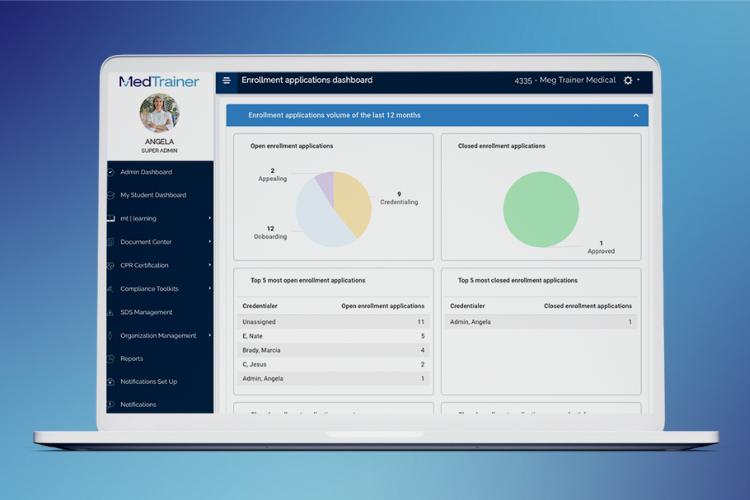Healthcare facilities and providers must complete medical and insurance credentialing to bill for patient care services. It’s a lengthy and tedious process that can take several months. Although time-consuming, it’s an essential step when onboarding a new provider.
Critical information can cause several downstream issues for providers and healthcare organizations when it isn’t correctly verified. In this blog, I’ll discuss the differences between medical and insurance credentialing processes and the issues that can arise from not accurately completing either process.
Medical vs. Insurance Credentialing
Most healthcare professionals require some medical and insurance credentialing to bill for patient care services. These may include physicians, advanced practice providers, nurses, dentists, and physical therapists. While medical and insurance credentialing are both important, they are distinct processes. Here are some differences:
| Medical Credentialing | Insurance Credentialing | |
| Process Outcome | Confirms provider’s eligibility and qualifications to bill for patient care services. | Registers a provider’s ability to bill for in-network insurance coverage. |
| Who Completes It | Healthcare organizations or third-party credentialing services. | Insurance carriers negotiate contracts with healthcare organizations. Third-party credentialing services may also handle this process with the insurance company. |
| Timeline | Several months, completed before insurance credentialing. | Several months, completed after medical credentialing. |
| Required Documents | Provider’s background and qualification documents include licenses, education, and work history. | Provider’s verified credentials, practice location, protocol agreement, Taxpayer Identification Number, and negotiated contract and rates. |
| Review and Renewal | Provider information is typically re-attested every 120 days or when updates to provider information occur. The entire re-credentialing process is typically completed every two years or as required by state laws and/or the healthcare organization. | Re-credentialing is typically completed every two years or as the insurance company requires. As provider medical credentialing information updates (i.e., license renewals, change in practice location, etc.), the insurance company also re-verifies information. |
Examples of Credentialing Issues in Healthcare
Lack of proper medical and insurance credentialing can lead to several issues for healthcare organizations and providers. Some examples of issues that can arise:
- Scope of practice issues: Not verifying a healthcare provider’s qualifications can cause scope of practice problems. You don’t want a physical therapist performing major heart surgery or a dentist providing emergency room care to a stroke patient. Additionally, not every provider has the exact scope of practice in every state. Credentialing validates a provider’s qualifications and scope of practice under state-specific laws and regulatory requirements.
- Loss of trust: Not completing a comprehensive verification of a healthcare provider’s qualifications can cause a lack of trust for all parties involved. For example, a healthcare organization forgets to update and verify a provider’s state license with the insurance carrier. The insurance company finds it expired and drops the provider from their network.
- Delay in start date: Since credentialing takes several months to complete, any issues with validating or providing information within a timely manner can delay the healthcare provider’s start date or approval for in-network insurance billing. For example, a provider gives their employer all required information promptly. However, the employer forgets to forward some information to the insurance company, causing contract negotiation delays. While the provider may be able to start with the organization, they cannot receive reimbursement through that specific insurance company. Therefore, the healthcare organization may delay the provider’s official start date.
- Unable to bill for or receive reimbursement for services: Providers can legally not bill for medical services by not completing medical credentialing. Furthermore, if insurance credentialing is incomplete, the provider and healthcare organization may not receive insurance reimbursement for services in the patient’s network.
Strategies to Prevent Credentialing Issues in Healthcare
Medical and insurance credentialing issues are pretty standard. There are many ways healthcare organizations and providers can prevent them. Some of these strategies include:
- Understand state laws: Both health organizations and providers must understand the state laws and requirements. Providers should also review mandatory reporting requirements for potential abuse and certain infectious diseases.
- Confirm required licensure: Some states and organizations require providers to obtain specific licenses and certifications, while others may not. A registered nurse can administer Botox injections in some states if adequately trained and certified. In others, only a nurse practitioner or other advanced practice provider can administer Botox after training. Employers and employees should understand the provider’s required licensure and certifications to avoid credentialing problems.
- Clearly articulate employment parameters: Healthcare organizations should ensure prospective providers understand contract details and what is required before signing. Digital provider profiles organize all information, documents, and communication to providers in one location. Hence, it is easy to check on the status of enrollments, see what verifications must be completed, and send reminders so no required information is missed.
MedTrainer offers a choice of comprehensive credentialing software and fully managed credentialing services. Make your healthcare organization’s medical and insurance credentialing a smooth, seamless process by using MedTrainer today.

Complete credentialing 3 weeks faster
